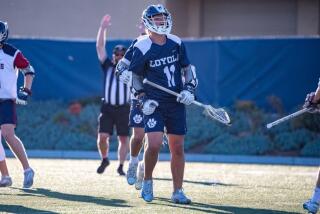Activity Cutbacks Not the Answer
- Share via
This year, the Orange Unified School District made severe cuts in co-curricular activities at each of its four high schools. The district has warned that these cuts are a prelude to those that will be made if the state cuts back any more funding.
The district is considering a number of alternatives to funding in its quest to balance the budget. They’re considering asking booster clubs to increase their support through more fund-raising, charging sports fees, transportation fees and anything else they can imagine. Many of these ideas seem like simple solutions on the surface but will have everlasting effects on our communities.
The so-called co-curricular or extracurricular activities at the high schools in the Orange Unified School District include: athletics, drama, band, choir, yearbook, school newspaper, debate teams and class advisers. The school district considers these activities extracurricular, therefore not needed in time of budget crisis.
Over the past 12 years, each of the four high schools has been given a budget of $18,000 to purchase equipment for all sports, boys and girls. This includes 18 different sports representing 40 levels.
Orange Unified has paid for coaching stipends (coaching salaries that range from $1,024 to $2,420 per season), officiating fees and transportation. Orange cut back about 30% of its costs in these areas this year. Some sports were cut at a lower level, and all activities lost at least one coach or adviser.
The thought that co-curricular activities are not an important part of the educational process is very disturbing. All of the above activities develop many of the disciplines required to become successful. Law-abiding citizenship, responsibility, teamwork and self-confidence are just a few of the qualities that can be learned on a field, playing court or stage.
Today, we find our communities filled with social problems. Our politicians and law-enforcement people tell us that we must fight these problems by educating students at a young age. Elementary and middle schools are now targets to educate many students about drug abuse, smoking and alcoholism.
The contradiction here is while we are spending more money to eliminate those problems, some school districts are cutting co-curricular programs, putting kids on the streets after school. This takes away a positive role model and replaces the coach or adviser with kids advising kids.
“Pay to Play”--whoever coined this idea is not looking past our immediate future. The idea that students or their families should pay fees for their participation in the so-called co-curricular activities is not considering the burden being placed on family finances.
It sounds so simple to charge a student fee to participate. But fees will limit the amount of activities a student will participate in and cause an unfair burden on families with more than one child. Some students will not participate at all. This is not really equal opportunity because some families can afford this, while many other families, some with single parents, cannot. Many times, students who need a disciplined structure, such as sports, cannot afford to “pay to play.”
Who really benefits from education that includes co-curricular activities? Certainly the student benefits. He or she will build a strong self-concept and will feel rewarded by accomplishment. Hopefully, these students will build a sense of pride, tradition and a sense of belonging--a strong foundation for the future.
School districts benefit from the many success stories. They produce young people growing up, having families and becoming productive members of society. All too often, the media belabor our failures. For every failure, there are thousands of successes.
Finally, our communities benefit. Many of you reading this are successful. You participated in co-curricular activities. You realized failure/success and developed a strong sense of belonging.
We should now demand our school districts to do the same for young students today. Give everyone a chance to participate, free of fees. Some might not have the money to pay. Can we allow many of our young people to be discounted from co-curricular activities simply because our school districts fail to recognize these activities as part of the curriculum?
Our school districts should be paying for these activities as part of public education. It is my sincere hope we use more logic as we move into the future.
More to Read
Sign up for Essential California
The most important California stories and recommendations in your inbox every morning.
You may occasionally receive promotional content from the Los Angeles Times.













